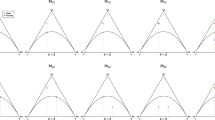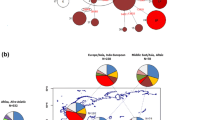Summary
It is shown that a simple preferential transmission of the PiZ allele by PiZ-heterozygous males for α1-antitrypsin deficiency cannot maintain the observed polymorphism at the locus without invoking any viability or fertility selection against the PiZ gene carriers (heterozygotes or homozygotes). From the data on frequencies of PiZ alleles in Europe, the estimates of such selection coefficients are shown to be of the order of 5–20%, which seems too large for natural populations. Furthermore, an analysis of 26 nuclear families, each ascertained through a heterozygous PiZ or homozygous ZZ child, does not provide statistical evidence for such a hypothesis.
Similar content being viewed by others
References
Arnaud P, Galbraith RM, Faulk P, Black C (1979) Pi phenotypes of α1-antitrypsin in Southern England: Identification of M subtypes and implications for genetic studies. Clin Genet 15:406–410
Arnaud P, Koistinen J, Wilson GB, Fundenberg HH (1977) 197-1 (Pi) phenotypes in a Finnish population. Scand J Clin Lab Invest 37:339–343
Beckman G, Beckman L, Nordenson I (1980) 197-2 phenotypes in Northern Sweden. Hum Hered 30:129–135
Bennett D (1975) The t-locus of the mouse. Cell 6:441–454
Blundell G, Frazer A, Cole RB, Nevin NC (1975) 197-3 phenotype in Northern Ireland. Ann Hum Genet (Lond) 38:289–294
Carrell RW, Jeppsson J-O, Laurell C-B, Brennan SO, Owen MC, Vaughan L, Boswell DR (1982) Structure and variation of human α1-antitrypsin. Nature 298:329–334
Chapuis-Cellier C, Arnaud P (1979) Preferential transmission of the Z deficient allele of α1-antitrypsin. Science 245:407–408
Constans J, Chakraborty R, Majumder PP (1982) Transmission of Z allele from heterozygous males for α1-antitrypsin deficiency: Additional family data. Am J Hum Genet 34:674–675
Cox DW (1980) Transmission of the Z allele from heterozygotes for α1-antitrypsin deficiency. Am J Hum Genet 32:455–457
Cleve H, Patutschnick W, Strecker K, Nevo S (1979) Inheritance of Pi-M subtypes. A study of 151 families with a total of 242 children and of 142 mother-child pairs. Hum Hered 29:351–354
Crow JF (1979) Genes that vilate Mendel's rules. Sci Am 240:135–146
Elandt-Johnson RC (1971) Probability models and statistical methods in genetics. Wiley and Sons, New York
Fagerhol MD (1967) Serum Pi types in Norwegians. Acta Path Microbiol Scand 70:421–428
Fagerhol MK, Eriksson AW, Monn E (1969) Serum Pi types in some Lappish and Finnish populations. Hum Hered 19:3–8
Frants RR, Eriksson AW (1978) Reliable classification of six PiM subtypes by separator isoelectric focusing. Hum Hered 28:201–209
Hartl DL, Hiraizuni Y (1976) Segregation distortion in Drosophila melanogaster. Genetics 86:321–355
Hoffmann JJML, van den Broek WGM (1976) Distribution of α1-antitrypsin phenotypes in two Dutch population groups. Hum Genet 32:43–48
Immarino RM, Wagener DK, Allen RC (1979) Segregation distortion of the α1-antitrypsin PiZ allele. Am J Hum Genet 31:508–517
Immarino RM, Wagener DK, Allen RC (1980) Response to Cox's letter. Am J Hum Genet 32:458
Karlin S (1968) Equilibrium behavior of population genetic models with nonrandom mating. Parts I and II. J Appl Prob 5:231–313, 487-566
Klasen EC, D'Andrea F, Bernini LF (1978) Phenotype and gene distribution of α1-antitrypsin in a North Italian population. Hum Hered 28:474–478
Piantelli M, Auconi P, Musiani P (1978) 197-11 phenotypes in newborns from Central and Southern Italy. Hum Hered 28:468–473
Sesboue R, Charlionet R, Vercaigne D, Guimbretiere J, Martin JP (1978) Genetic variants of serum α1-antitrypsin (Pi types) in Bretons. Hum Hered 28:280–284
Silver LM (1981) Genetic organization of the mouse t complex. Cell 28: 239–240
Suarez BK, Pierce JA (1982) Is the alpha-1-antitrypsin polymorphism maintained by segregation distortion? (Abstract) Am J Phys Anthropol 57:234
Turner BC, Perkins DD (1979) Spore killer, a chromosomal factor in Neurospora that kills meiotic products not containing it. Genetics 93:587–606
Vogel F, Motulsky AG (1979) Human genetics: problems and approaches. Springer, Heidelberg New York
Author information
Authors and Affiliations
Rights and permissions
About this article
Cite this article
Chakraborty, R., Constans, J. & Majumder, P.P. Transmission of the PiZ allele for α1-antitrypsin deficiency: Population genetic considerations. Hum Genet 62, 193–197 (1982). https://doi.org/10.1007/BF00333517
Received:
Issue Date:
DOI: https://doi.org/10.1007/BF00333517




